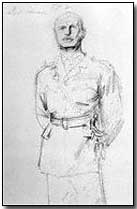Who's Who - Earl of Cavan
 Frederick Rudolf Lambart, 10th
Earl of Cavan (1865-1946) was brought back from retirement in 1914 and rose
to become one of the British Army's more successful commanders during the
First World War.
Frederick Rudolf Lambart, 10th
Earl of Cavan (1865-1946) was brought back from retirement in 1914 and rose
to become one of the British Army's more successful commanders during the
First World War.
Lambart chose retirement from the army at a relatively early age in 1913 while aged only 48; his reason - to dedicate himself to his estate in Hertfordshire.
With the outbreak of general war in August 1914 he was recalled from reserve and briefly handed command of a Territorial brigade, the 2nd London Infantry. The following month he succeeded the wounded Robert Scott-Kerr as commander of 4th (Guards) Brigade.
June 1915 saw Cavan promoted to command of 50th Division; a mere two months on he was appointed the first commander of the Guards Division.
The following January, 1916, Cavan was placed at the head of XIV Corps, a command he held until March 1918, during which time he established a deserved reputation as perhaps the best corps commander on the Western Front.
It was with XIV Corps that Cavan was despatched to the Italian Front in the wake of the Caporetto fiasco in November 1917. The following March Cavan was formally appointed Commander-in-Chief of British forces on the Italian Front.
It was in this capacity that Cavan led the Italian Tenth Army which struck a decisive bow at the Battle of Vittorio Veneto, the action which sounded the final death blow of the Austro-Hungarian army towards the close of the war.
The Earl of Cavan, Frederick Lambart, died in 1946.
Click here to read Cavan's report on British involvement in the Battle of the Piave River in June 1918.
The Austro-Hungarian declaration of war was the first ever delivered by telegram.
- Did you know?
